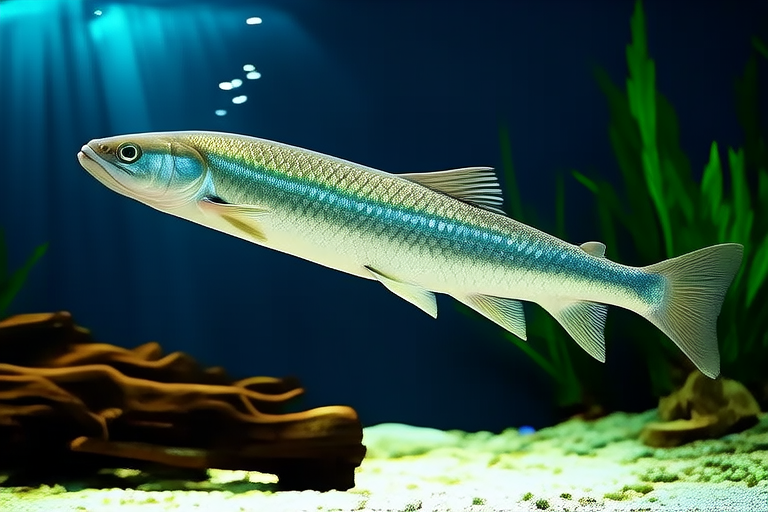Top 10 Reasons Why an Arowana Makes a Unique Addition to an Aquarium
The Scleropages formosus, commonly known as the Asian arowana or dragonfish, is a striking and captivating freshwater fish that has earned its reputation as a symbol of good luck and prosperity in many cultures. This article delves into the top 10 reasons why an arowana makes a unique addition to an aquarium, exploring its appearance, behavior, care requirements, mythological significance, and interactions with its environment or other fish.
1. Exquisite Appearance
The arowana’s most notable feature is its sleek, elongated body covered in large, iridescent scales that shimmer with hues of green, red, gold, and blue. The dorsal fin is long and flowing, while the pectoral fins are short and rounded. The tail fin is deeply forked, adding to the fish’s graceful appearance. These features make the arowana an eye-catching centerpiece in any aquarium. Its vibrant colors and elegant movements are sure to mesmerize viewers, making it a focal point for aquarium enthusiasts.
2. Mythological Significance
In Asian culture, the arowana is often associated with the dragon, a mythical creature that symbolizes power, strength, and good fortune. This connection is due to the fish’s resemblance to the legendary Chinese dragon, particularly its elongated body and scaly appearance. As a result, the arowana is considered a symbol of good luck and prosperity, especially in Feng Shui practices. Many people believe that keeping an arowana in their home can bring them wealth and success. This mythological significance adds an extra layer of interest and cultural value to owning an arowana.
3. Intelligent Behavior
Arowanas are known for their intelligence and problem-solving abilities. They can recognize their owners and even respond to their presence. Some arowanas have been observed jumping out of the water to catch food, showcasing their agility and coordination. Their intelligence also means they require mental stimulation, such as toys or puzzles, to keep them engaged and prevent boredom. This behavior makes the arowana a fascinating and interactive pet, offering a unique bond between owner and fish.
4. Care Requirements
Maintaining a healthy arowana requires careful attention to water quality, temperature, and diet. The ideal water temperature for an arowana is between 78°F and 82°F (25°C to 28°C), with a pH level of 6.5 to 7.5. Regular water changes and filtration are essential to maintain water quality. Arowanas are carnivorous and require a diet rich in protein, including live or frozen foods such as feeder fish, shrimp, and insects. Proper feeding and care ensure the longevity and well-being of these magnificent creatures.
5. Large Size and Longevity
Arowanas can grow up to three feet in length and live for over 20 years, making them a long-term commitment for aquarium owners. Their impressive size and lifespan add to their appeal as pets, but they also require a spacious tank and regular maintenance. Arowanas need at least 200 gallons of water, with ample swimming space and hiding spots. Providing adequate living conditions ensures the fish’s health and happiness throughout their extended life.
6. Environmental Interactions
Arowanas are known for their territorial behavior and predatory instincts. They establish dominance within their environment and can be aggressive towards other fish, especially those of similar size or species. However, when provided with sufficient space and enrichment, arowanas can coexist peacefully with compatible tank mates. It’s important to research and choose appropriate companions for your arowana to ensure a harmonious aquarium ecosystem. Additionally, arowanas play a vital role in maintaining the balance of their natural habitats by preying on smaller fish and invertebrates.
7. Conservation Status
The arowana is listed as vulnerable on the International Union for Conservation of Nature (IUCN) Red List, primarily due to habitat destruction and overfishing. Efforts are being made to conserve this species through captive breeding programs and protected areas. Responsible ownership includes supporting sustainable breeding practices and avoiding wild-caught specimens. By choosing responsibly sourced arowanas, aquarium enthusiasts can contribute to the conservation of this magnificent fish.
8. Scientific Interest
Arowanas are of significant interest to scientists studying evolution and adaptation. They belong to the family Osteoglossidae, which dates back to the Cretaceous period, making them one of the oldest groups of bony fishes. Their unique characteristics, such as their ability to breathe air and their electroreceptive organs, provide valuable insights into the evolutionary history of fish. Research on arowanas contributes to our understanding of biodiversity and the importance of preserving ancient species.
9. Specialized Feeding Behavior
Arowanas exhibit specialized feeding behaviors that are both fascinating and challenging to replicate in captivity. In the wild, they hunt for prey near the water’s surface, often leaping out of the water to catch flying insects or small birds. This behavior, known as “surface feeding,” is a hallmark of the species and adds to their allure as pets. However, replicating this behavior in captivity requires careful consideration of tank design and feeding techniques. Providing arowanas with opportunities to display their natural hunting instincts can enhance their well-being and enrich their lives.
10. Social Dynamics
Arowanas are social animals that thrive in groups. In the wild, they live in schools, forming complex social structures. In captivity, arowanas can benefit from the company of their own kind or compatible tank mates. However, introducing new fish to an established group requires careful planning and monitoring to avoid aggression. Establishing a stable social hierarchy within the aquarium can promote peaceful coexistence and reduce stress for all inhabitants. Understanding and respecting the social dynamics of arowanas is crucial for creating a thriving and harmonious aquatic environment.
In conclusion, the arowana is a truly remarkable fish that offers a unique addition to any aquarium. Its stunning appearance, mythological significance, intelligent behavior, and specialized care requirements make it a fascinating and rewarding pet for experienced aquarists. By providing proper care and support, aquarium enthusiasts can enjoy the beauty and wonder of these magnificent creatures while contributing to their conservation and well-being.
